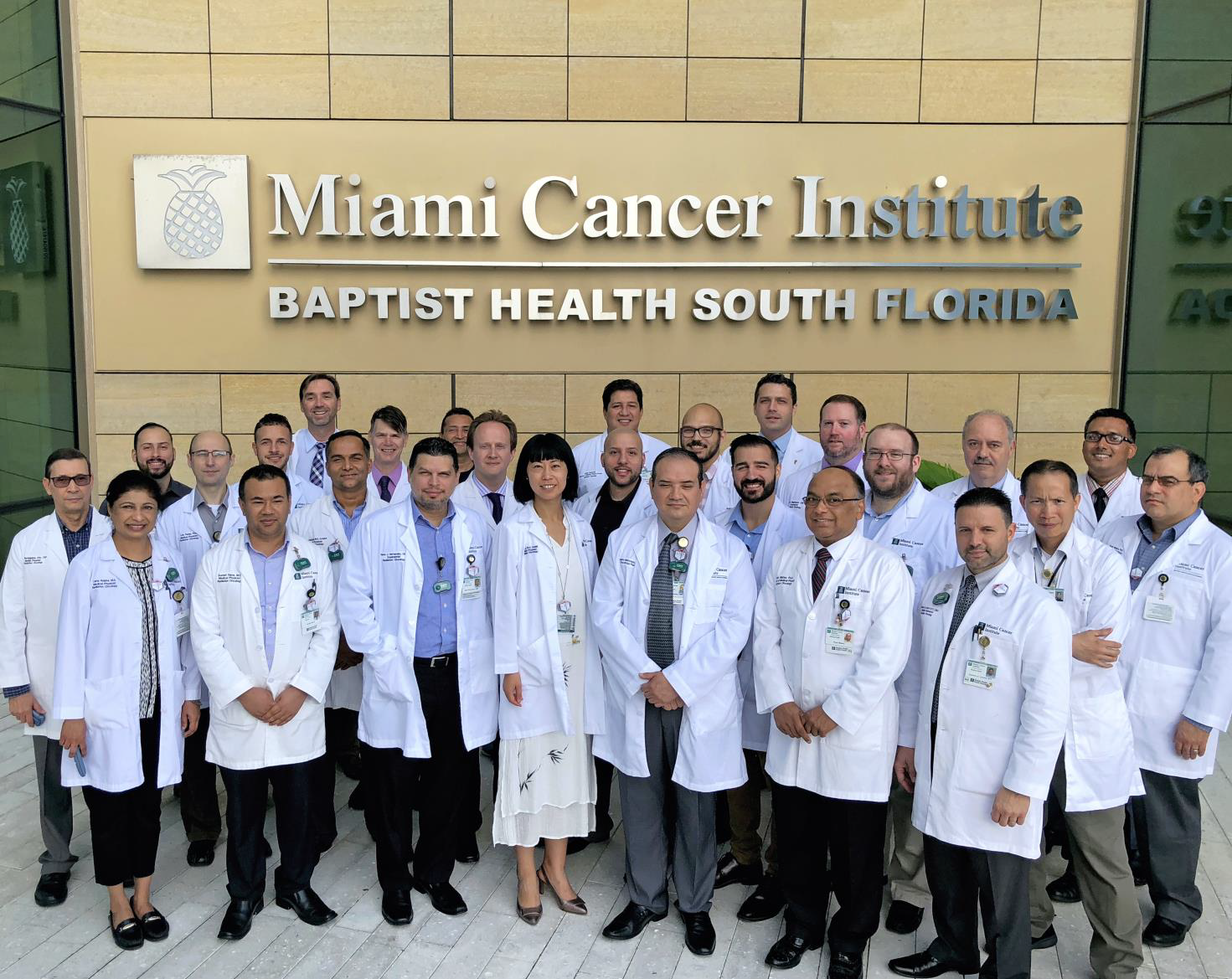
The Miami Cancer Institute team.
Miami Cancer Institute, a part of Baptist Health South Florida, is a state-of-the-art center that serves as the primary destination for patients from the Southeast U.S., the Caribbean and Latin America. The center is one of a few centers in the world capable of providing all the latest available radiation therapy technologies, and it started treating patients in January 2017. When it was time to determine a treatment planning system that would encompass the various delivery platforms, including proton therapy, RayStation became a natural choice.
The $430 million, 395,000-square-foot Miami Cancer Institute (MCI) offers their patients access to almost all radiation delivery technologies commercially available and does it all under one roof. MCI currently treats with IBA Proteus PLUS proton therapy, ViewRay MRIdian MR Linac, Gamma Knife Icon Radiosurgery, CyberKnife, Radixact TomoTherapy, True Beam, brachytherapy and radionuclide therapy.
“The idea was that we want to use the best available technology to provide the most optimal care, and the building was designed to house all these different technologies to accomplish this. By having every technological tool in the toolbox, one can better evaluate and customize the best treatment plan for every patient,” said Craig McKenzie, director of medical dosimetry at MCI.
“Other centers might have all the technology available to them, but in different locations. We can customize our patient’s treatment to be mono-technology-based or perhaps capitalize on dosimetric advantages of using multiple technologies to deliver patients the best possible plan. That is unique,” said Alonso N. Gutiérrez, chief physicist at MCI.
The First Selection of RayStation
For this world-class center, the choice of the treatment planning system (TPS) was essential. The selection of RayStation as sole TPS for the proton therapy at MCI “was a natural choice,” according to Gutiérrez.
“RayStation is a clear market leader within proton therapy. Proton therapy is evolving fast and so is RaySearch, catering to their customers’ needs with large development teams that can implement changes fast. The time from development until we can use new features clinically has shortened,” he continued.
RayStation’s functionality and speed were key factors in the decision to choose RayStation, said McKenzie. “RayStation gives us the best results in planning and evaluation, and does it fast,” he stated.
Gutiérrez also points out that RayStation’s ability to support many different delivery systems was an important part of the selection, for future implementation at the clinic.
“We are interested in using RayStation as the premier choice for all technologies in the future, moving toward a single TPS,” he said.
As of now, the center primarily uses RayStation for proton planning but will start using it for photon and TomoTherapy planning.
“We are currently in training for photon, and we already use some of the tools available to us. For example, we do our evaluation comparisons in RayStation. We are actively working on using RayStation to plan for TomoTherapy, and our goal is to treat a patient by the end of October,” Gutiérrez said.
Efficiency Gains
Gutiérrez and McKenzie both emphasize the improvements that RayStation provides in terms of the combination between clinical excellence and workflow efficiency.
“RayStation is very manageable, which makes our lives easier. The automation features through scripting help us remove time-consuming steps, and it makes sure that our dosimetrists can spend more time on making plans better instead of spending time on redundant tasks.
We simply don’t have to compromise on quality,” Gutiérrez said.
The analytics and automated capabilities of RayStation are a few of the functions that make it superior to other TPS, said McKenzie: “RayStation helps me make the best plans possible, and the analytics can help us interpret those plans. We know that we are already saving time, and we will be able to fully benefit from those gains soon when we are done implementing our new ways
of working.”
Support is Key
Superior clinical planning, gains in efficiency and a great support team are some of RayStation’s most valuable benefits, according to McKenzie.
“RaySearch has some of the best support on the market. They are dosimetrists with strong clinical experience and are dedicated to help and understand our issues. We can continuously rely on them to respond quickly, listen to our needs and follow through to help with resolution,”
he said.
Support was one of the most important cornerstones during the implementation of RayStation, Gutiérrez said. “The implementation went very well, and we got the support that we needed from RaySearch. We started with proton and got specialized training, we then moved forward with photon and now we are working on TomoTherapy. We are looking forward to further integrating RayStation in more aspects of our operations.”
Future of the Collaboration
Efficiency and speed in combination with good quality are essential in oncology today, and Gutiérrez believes that it will become even more important as new technology develops.
“I think that artificial intelligence (AI) will mean a great deal for improvements in clinical efficiency without sacrificing treatment plan quality. With the promises of AI, one could expect faster planning times, better standardization of plan quality within a clinic, and this could lead to better quality plans. In this current healthcare environment, high-quality planning tools with superb efficiencies will be necessary moving forward. This is something that RaySearch understands, and I’m very excited to see the OIS RayCare in this equation later,” he concluded.
For more information: www.raysearchlabs.com


 December 11, 2025
December 11, 2025 









